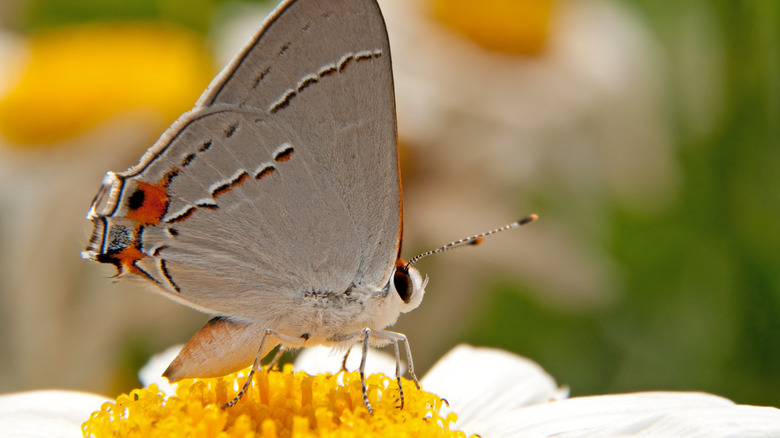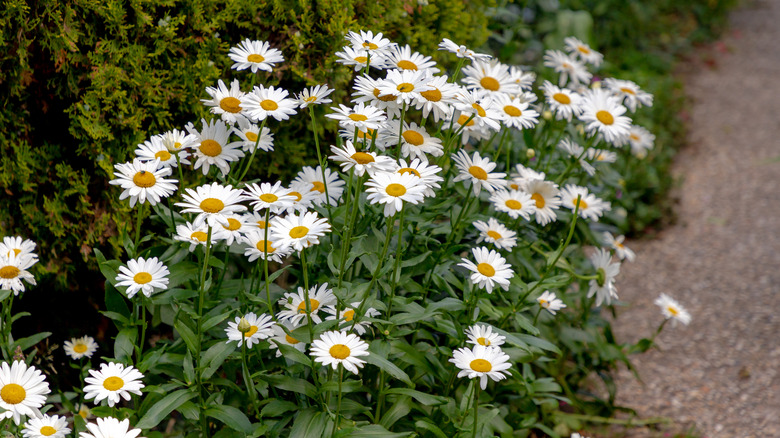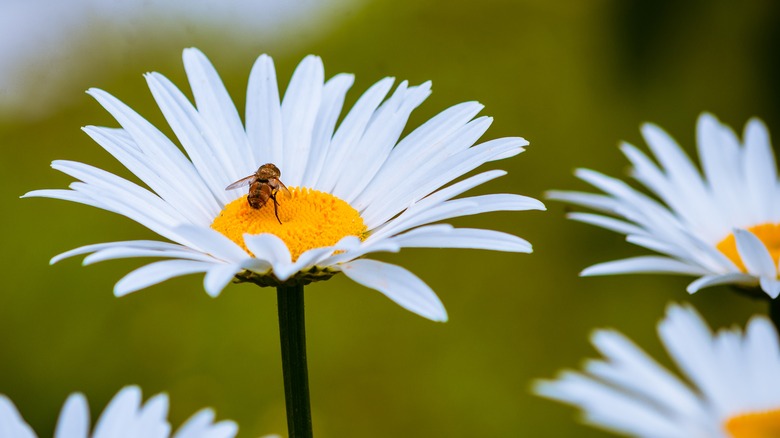The Stunning Daisy Variety That Will Fill Your Yard With Pollinators
If you've been looking for a gorgeous flower to add to your butterfly garden, the shasta daisy (Leucanthemum x superbum) could be the perfect fit. This perennial blooms from June to September with white flowers that have yellow centers and can attract butterflies to your garden or yard, as well as other pollinators like bees. Not only will shasta daisies provide nectar for hungry pollinators, but growing these simple yet elegant flowers will make your outdoor space beautiful throughout the summer. These flowers are a hybrid of several types of daisies, including the Nippon daisy and the European oxeye daisy. If you live in USDA hardiness zones 5 through 9, shasta daisies will be a wonderful addition to your garden. They can also grow between 1 and 4 feet tall, depending on the variety, which could make them great for bordering your yard or home.
When planting shasta daisies, be aware that they tend to spread and you may need to take steps to keep them from stretching out too much. Otherwise, these plants could overtake your garden. Additionally, while many daisies are known to be toxic to pets, there is debate that shasta daisies may not be harmful. Since it isn't totally clear if these daisies are dangerous for pets, it's best to keep your furry friends away from them. By planting shasta daisies in the spring, you can enjoy their blooms and bring more pollinators into your yard and garden.
Growing shasta daisies to fill your yard with pollinators
Shasta daisies can be a wonderful addition to your flower beds, butterfly garden, or yard, and can attract a variety of pollinators. Butterflies are commonly drawn to this plant as well as other daisies because of the "eye" in the middle of the flower. These pretty yellow centers have tons of small florets that contain nectar, allowing butterflies to hang out on one flower and drink as much nectar as they'd like. Native bees and honey bees will likely also love to buzz around your shasta daisies. Surprisingly, these flowers may also be attractive to ladybugs, lacewings, and other beneficial insects, making them a pollinator haven for your yard.
Because these plants can spread, it's important to cut the stalks after the flowers begin to die to stop the seeds from being released. This could also help the plant to grow even more blooms, in addition to preventing the shasta daisies from overrunning your garden. You may also need to divide the plant's clumps after a few years at the start of spring to keep your shasta daisies healthy.
Planting and caring for the stunning shasta daisy
Thankfully, it is relatively easy to care for shasta daisy plants. These flowers love to be in direct sunlight, though they will still do well with a little shade if your climate is rather hot or dry. Otherwise, shade might prevent the plant from producing as many flowers. You can start your flowers from seed once the temperature has hit 70 degrees Fahrenheit. Set the seeds in a sunny spot in your garden in spring and place about ⅛th of an inch of soil over them. Make sure that your plants have approximately 1 to 2 feet between them so they have room to grow. Shasta daisies prefer well-draining soil that has a neutral pH level. When the ground is overly wet, these flowers can suffer.
Additionally, shasta daisies do best in soil that's only moderately fertile, as having overly fertilized dirt could cause the plants to produce more leaves than flowers. Since these plants can tolerate drier soils and drought to an extent, you may not need to water them unless you're getting less than an inch of rain per week. If you choose a variety of shasta daisies that grows rather tall, stakes might need to be used to keep your plants upright. As these flowers grow, enjoy the butterflies and bees that flock to your yard.


